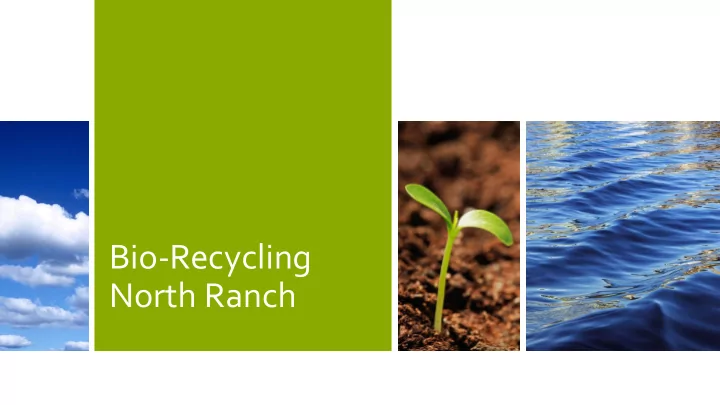

Bio-Recycling North Ranch
Operation overview • The project operates in accordance with WAC 173-308 and is permitted by Ecology. The Facility is located at 820 E. Webb Hill Rd. Union, Washington and is located in Mason County. • The Facility operations currently consist of a treatment plant and an adjacent 293- acre land application site. The treatment plant employs an alkaline stabilization process using quicklime. • The adjacent land application site receives surface applications on a year round basis* to enhance the production of agricultural crops. 2 Sep 15, 2017 *Will be seasonal by Fall 2018
Operations cont. • The plant primarily serves as a further treatment option for septic tank pumping companies. These companies typically pump from local septic tanks, small wastewater treatment plants, sewage pump station vaults, vault toilets, cesspools, holding tanks, RV dump stations, portable toilets, marine sanitation units and limited restaurant grease waste. • Each septage delivery is weighed on truck scales, unloaded, screened, degritted, mixed with lime and held in above ground tanks for 24 hours at the prescribed pH resulting in Class B biosolids. • Samples are collected and analyzed according to state and federal regulations and results are reported to Ecology. 3 Sep 15, 2017 Footer text here
The numbers • Average customer deliveries approximately 60,000 gallons per day, 5 days per week • Dewater over 95% of processed material • In 2016 this reduced site loading by 116lbs PAN per acre (over 1130 DT hauled offsite 2016, 1162 DT hauled offsite 2017) • Current applications of biosolids at North Ranch are 45-50% of the agronomic rate of 150lbs PAN per acre per year. 4 April 5, 2018 Footer text here
The “gem filtrate” produced from dewatering and DAF is pumped out to the fields 5 March 9, 2017
Summer 2017 6 Sep 15, 2017 Footer text here
2017 Post-harvest 7 Sep 15, 2017 Footer text here
Title and Content Layout with Chart Chart Title 6 5 4 3 2 1 0 Category 1 Category 2 Category 3 Category 4 Series 1 Series 2 Series 3 8 March 9, 2017
Spring 2016 North Ranch Cropping and Grazing Management 9 March 9, 2017
Dewatering • Dewatering is accomplished through a gravity belt thickener and belt filter press • A flocculant is introduced to our class B material and is then pumped onto the gravity belt thickener • The solids captured by the ‘GBT’ are conveyed to the belt press where more of the liquid is squeezed out • The combined liquid from both is called ‘filtrate’ • The solids produced are class B biosolids • Those solids are hauled to permitted farms in eastern Washington and southwest Washington 10 March 9, 2017
Dissolved Air Flotation (DAF) • “Filtrate” from the belt press/gbt is fed into the feed tank for the DAF unit • More flocculant is added and micro air bubbles are introduced to the liquid stream • Solids are floated to the surface and skimmed off into a separate tank • The solids are pumped to the solids product pit (to be hauled offsite) • The liquid produced is called “Gem Filtrate” and this is what is applied to the fields 11 March 9, 2017
We discovered a problem • Ground Water monitoring wells and Lysimeters • Beginning in 2007 ground water monitoring wells and lysimeters were installed on the site • To date 10 monitoring wells and 2 lysimeters have been installed to monitor ground water on site and down gradient • Nitrates • Lab analysis of ground water on site showed elevated nitrates in the lysimeters and some of the monitoring wells. • Currently there are two monitoring wells with nitrates above the federal maximum of 10ppm* • Both of the lysimeters have dropped below 10ppm (4.93 and 5.3ppm)* *As of 2017 4 th quarter 12 April 9, 2018
How are we correcting the problem now and into the future? • Apply less nitrogen to the fields • Limit customer deliveries • Treatment plant deliveries were cut off Dec. thru Feb. 2016/2017 • Approximately 10% less volume during those months • Dewatering/DAF • Cropping and Livestock management • Crop health (weed/pest control and nutrients) • Maximizing harvest (haying/grazing) • Stocking rate and livestock rotation • Limit application seasonally • Winter storage 13 March 9,2017
New Surface Impoundment New Surface Impoundment
Recommend
More recommend